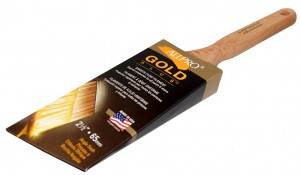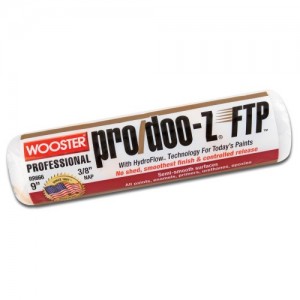Read on for brush and roller cover loading tips from The Wooster Brush company:
How to Load a Brush
- Dip the brush only about a third or halfway into the paint. To avoid dripping and keep your fingers clean, do not sink the brush up to its metal ferrule.
- Let excess paint drip for a moment, then lightly tap both sides of the brush against the interior wall of the can or bucket. Scraping excess paint on the lip of the can is messy and counterproductive because it removes the paint you just loaded into the brush.
- As you paint, make sure to keep a wet edge, and continue to paint from that point forward. Use long, smooth strokes and refill the brush whenever the paint starts to break up without covering the surface properly.
Note: The bigger (and thicker) a brush is the more paint it will take to the wall. A beginning painter may want to start with a smaller brush. A thin angle sash style brush is a good choice for practicing precision painting.

How to Load a Roller Cover
- Many painters “break in” a roller cover by priming it with water or thinner. In our lab we never prewet a cover before painting. If you choose to, you must spin it out with five or six strong pumps so it is only lightly damp. Then take even more moisture out by blotting the cover with a paper towel. Wooster recommends conditioning only for water-based paints, using water.
- Use a liner in the paint tray to save time during cleanup. Thoroughly mix the paint, then pour some in the well of the tray. Don’t overfill—the well should be half empty. You need room to roll excess paint onto the tray’s roll-off area.
- With the roller cover on the frame, drag some paint with the edge of the cover from the tray well back onto the roll-off area. Do not submerge the cover. Roll it on the grid toward the well using several quick forward strokes, then drag more paint back with the cover. Continue until it is completely saturated but not dripping.
- Patience is very important when loading a cover. It takes time to work paint through the fabric down to the core, especially with woven fabrics. Allow several minutes for the initial loading.
- Do not “starve the cover” by attempting to paint too far without refilling—that can compress the fibers and make it more difficult to reload, forcing you to spend more time in the tray.

Visit a Spectrum Location near you to learn more about the specific Wooster products we offer and their benefits.
Shop Online Here for in-store pick-up, curbside pick-up or delivery within 5 miles of your neighborhood Spectrum Paint location.

